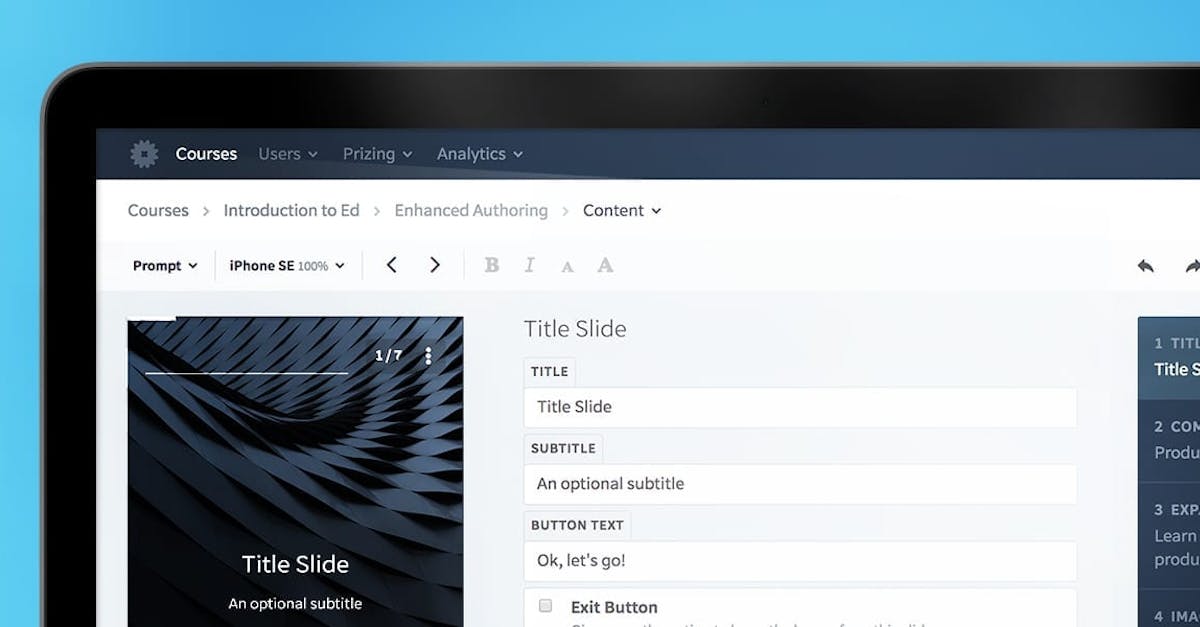Elearning Design – 10 Things to Avoid

Designing efficient and useful eLearning is by no means an easy job. Instructional designers must study, research and understand a lot before they can even begin to create eLearning.
Nobody’s perfect, and mistakes are made by even the best eLearning professionals in the world. However, only those who learn from their mistakes and don’t repeat them go on to become masters in their field. However, making mistakes can be costly, both financially and professionally. Wouldn’t it be great if you could learn from the mistakes of others? Actually, you can. This article has 10 tips on what not to do when designing eLearning, compiled for you so that you don’t have to learn the hard way, saving your frustration and loss.
1. Not Selecting the Right Authoring Tool
You’ll be building all of your eLearning courses on an authoring tool, thus correctly selecting the most important decision you can make while applying your elearning design. How do you know which one is the right one? By researching all the available authoring tools on the market, especially their features and functions and then writing down a list of features you want in your authoring tool. Use this list to buy the perfect authoring tool that suits all your needs. Extra features never hurt anybody so keep that in mind.

2. Not Knowing the Target Audience
Although it is unlikely that the instructional designer doesn’t know the target audience, sometimes they might not make much of an effort to know their interests, experience, tech-proficiency, learning needs and education. In this learner-centered industry, this is a mistake you cannot afford to make. Knowing who your target audience is, isn’t enough. You need to know them inside and tailor the course to their needs and preferences so you can make the best elearning design.

3. Choosing the Wrong Learning Strategy
A learning strategy is only decided once the instructional designer has thoroughly gone through the content and has created a plan in their minds. However, certain instructional designers don’t pick the learning strategy according to the content, they pick the learning strategy first and make the elearning design suit it. This is something that is bound to lead one to failure. You simply cannot pick the right learning strategy without analyzing the content first.

4. Losing Track of Learning Objectives and Goals
Instructional design is something that requires a lot of creativity, like any other design. And like any other designer, instructional designers can sometimes get carried away and lose track of the elearning design objectives and goals of the eLearning course or module they’re designing. The learning goals and objectives should act as guides throughout the entire creation of the eLearning course, and you should take great care not to stray too far from them.

5. Creating Text-Heavy Courses
This is something that should go without saying in this day and age. Use more interactivities and visuals, as well as infographics and videos. Nobody has the time or the patience to read walls and walls of text these days, as a lot of eLearning is accessed on smartphones. There are times when you’re tempted to paste lots of text on a single screen, or you cannot find the right way to present it, but those are the times when you should use your creativity and your sense of design. A combination of chunking and the right elearning design can easily help you escape text-heavy screens.

6. Not Providing Clear Enough Instructions
The job of the instructional designer is to build an eLearning course for learners that has clear and easy-to-understand instructions. The learning experience should be a smooth one, requiring every interactivity, quiz and assessment to come with straightforward instructions so as not to confuse the learner. Unclear instructions may discourage the learner, leading them to skip the slide in question or leave the course entirely.
7. Creating A Course with No Assessments
Assessments are an integral part of an eLearning course. They challenge the learners, helping them determine where they stand while also helping the organization determine whether the learners are retaining the information they learned or not. A course with no assessment serves no purpose.
8. Using Irrelevant Content
The eLearning course is primarily meant to impart knowledge and teach skills to learners. Aesthetics are added to engage learners but that is where their utility ends. Don’t get carried away and add lots of aesthetically pleasing visuals and graphics at the cost of relevant content and subject matter. In fact, the ideal eLearning course shouldn’t contain any irrelevant information at all. Every element must have a purpose.
9. Adding Confusing Navigation
Navigation is a part of the overall learner experience and plays an important role in the success and failure of an eLearning course. It should take no more than two clicks or taps for the learner to get from one point of the course to another. This is a rule of thumb that must be utilized in any eLearning course you create. Confusing navigation can lead to skipped courses, and thus the failure of your course.
10. Not Integrating the Latest Technologies
eLearning is fast-paced, dynamic field where developments and trends take place on a daily basis. In order to be a successful instructional designer, you must stay up-to-date with any eLearning technologies that appear on the market, and must know how to utilize them in your course for the learner’s advantage. Using obsolete technology, and even not using contemporary eLearning technologies, is the surest path to failure.
Hopefully, these tips will help you create a flawless eLearning course that fulfils all the organizational goals as well as the business needs of your client (or your own organization). Remember that the best tool you need to create an amazing eLearning course is your mind.
If you would like to learn more about how to build the most effective employee training strategy!
If you’d like to know more about how EdApp’s mobile learning platform can help your internal training practices, get in touch at enquiries@edapp.com. You can also try EdApp’s Mobile LMS and authoring tool for free by signing up here.
Curated course examples
Author
Guest Author Daniel Brown
Daniel Brown is a senior technical editor and writer that has worked in the education and technology sectors for two decades. Their background experience includes curriculum development and course book creation.
